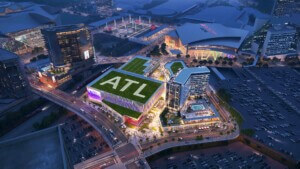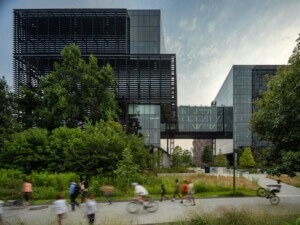On Sunday, all eyes will be on Atlanta’s Mercedes-Benz Stadium, the new arena that, less than 18 months after opening, is hosting the biggest sporting event in the nation: Super Bowl LIII. The National Football League (NFL) championship game—this year between the New England Patriots and the Los Angeles Rams—will be played with an architectural backdrop unlike anything in the world.
The $1.5 billion Mercedes-Benz Stadium is the most sustainable sports facility on earth. It is LEED Platinum and the only stadium of its kind with a kinetic, retractable roof. Designed by HOK in collaboration with BuroHappold Engineering, the building broke ground in 2014 and officially opened in August 2017 during the Atlanta Falcons’ pre-season. The sculptural structure replaced the 25-year-old Georgia Dome which was demolished the previous month.
Ahead of the game this weekend, here’s everything you need to know about the 2-million-square-foot Mercedes-Benz stadium:
Situated in downtown Atlanta, the Benz (as locals call it) houses 71,000 seats for NFL games and 32,456 seats for Major League Soccer games. It features a motorized scrim attached to the roof structure that can cover several sections.
Designed to emulate the Pantheon in Rome, it features a semi-transparent retractable roof that’s nicknamed “the oculus” that lets sunlight into the interior. Bill Johnson, design principal of HOK’s Kansas City office, said this “literal out-of-the-box” thinking was what won the over Falcons’ owner Arthur Blank who bankrolled the project.
“We wanted to move away from the typical square roofs you see on most stadiums and come up with something that created energy in the middle,” Johnson said. “The vision was that the opening would create a very tiny pinpoint of light on the Falcons’ logo at the 50-yard line, and as the roof retracted, the spotlight would become bigger and bigger.”
The stadium’s kinetic roof consists of eight, 200-foot-long triangular “petals” made of lightweight ETFE (ethylene tetrafluoroethylene). These petals are fixed to 16 individual tracks that can move at different speeds. The Benz now holds the record for the largest application of a single ETFE membrane in the world at 143,000 square feet.
The angular facade of the Benz consists of wing-like sections made of insulated metal panels that wrap around the bowl. As a nod to the swooping wings found on the Falcons’ logo, these sections overlap one another and create a feeling of movement on the exterior. The base of the building features a floor-to-ceiling glass curtain wall that lets light into the facility during the day and serves as a 16-story panoramic window to the city.
To Johnson, the success of Mercedes-Benz Stadium has been its ability to create social experiences for visitors. “Fans’ tastes have changed and people want a big, game-day experience,” he said. “Some of it is driven by social media, and some of it is driven by younger fans who want to get up and move around throughout an event, gathering together and watching things from different angles.”
Several aspects define the Benz as ultra-green. It’s powered by 4,000 photovoltaics, including an array of solar panels designed as carports. Alone, these generate 617 kilowatt-hours of energy each year for the stadium and the surrounding neighborhoods. According to Johnson, up to 10 NFL games can be powered with this amount of energy.
Additionally, underneath the stadium is a 600,000-square-foot cistern that can hold up to 2 million gallons of rainwater. Johnson said the intervention has helped decrease flooding in this area of Atlanta, while simultaneously providing irrigation for local trees.
One of the most impressive features of the Benz, according to Johnson, is the 360-degree halo scoreboard that wraps the oculus. It stretches 1,075-feet-wide and six stories high. Over 4,000 miles of fiber-optic cable support the ring-shaped screen, as well as the 2,000 televisions, and other technology found in the building.
While this is the first time the Benz has hosted a Super Bowl, it’s the third time Atlanta has won the bid in 25 years. The city put out a proposal midway through the construction of the new stadium. Post-opening, its first big test came last month when it played host to the 2018 Chick-fil-A Peach Bowl. The college playoffs will come back to the Benz in late December and next year, it will host the NCAA Men’s Final Four.











